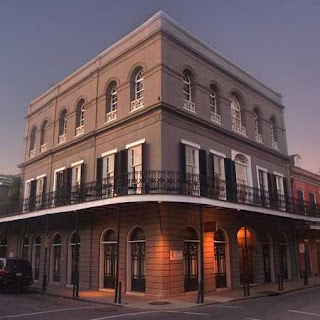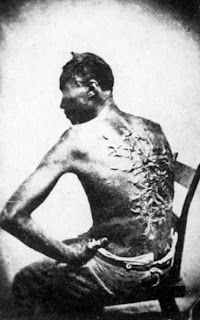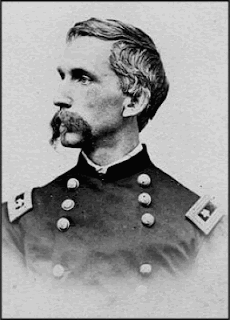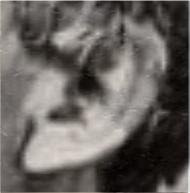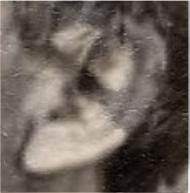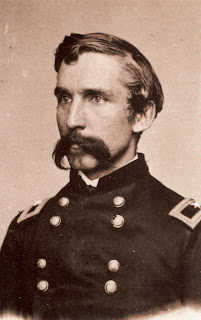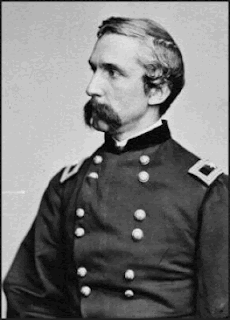This impressive building on the left used to be owned by actor Nicholas Cage before he went broke and lost it among several other properties he owned. I saw that the mansion was going up on the auction block and I was honestly quite stunned that Nicholas Cage owned a building with such a gruesome history. This building was the site of alleged horrific mutilations, murder and things so terrifying that even Stephen King couldn’t write it on his best day. I actually want to shake the hand of the realtor who even managed to get Nicholas Cage to look at the building let alone get him to buy it, given the history of violence around it.
The LaLaurie mansion was owned by Dr. Louis LaLaurie and his wife, Delphine LaLaurie. She was born in about 1775 and she was twice widowed by the time she married Louis in 1825. Before she married him, she was married to a slave trader, and as a girl, her parents were allegedly killed in a slave uprising, which undoubtedly left her a disturbed creature. The LaLauries bought the mansion on Royale Street in New Orleans together in 1831. The couple was among the creme of New Orleans society and Madame LaLaurie, as she was known, regularly entertained guests with lavish parties in her opulent home. Little did New Orleans society know, Madame LaLaurie was torturing her slaves in the most vile and wicked ways.
Rumors began amongst the LaLaurie’s neighbors about possible mistreatment of slaves in 1833 after an incident with a 12-year-old slave girl. She was brushing Madame LaLaurie’s hair and caught a snag. It enraged the Madame and the slave girl was viciously whipped. As she tried to escape, she fell from the balcony and was killed. The body was brought into the house immediately as to not arouse gossip among the neighbors but it was too late — they had seen everything and saw the slave girl being buried under a tree in the yard. They reported it to the authorities and a judge, also a friend of the LaLauries, was sent to examine the welfare of the slaves. He ruled that all of the LaLaurie slaves be removed from the home and sold at auction but the LaLaurie relatives bought the slaves back and returned them to the mansion.
The next year, during yet another LaLaurie party, a fire broke out in the kitchen, which was separated from the actual house. The firemen broke into the kitchen and found two slaves chained to the stove. It was believed that the slaves started the fire themselves in order to draw attention and hope to secure their freedom, at least from being chained to the stove. After this incident, the LaLauries fled their home in New Orleans and disappeared from society altogether. Some say they escaped to Paris, while others say they lived on the outskirts of the city.
Over the years since the LaLauries fled New Orleans, the story got bigger and bigger. No one knows for sure exactly how far the horror went in that house but a local newspaper wrote an article that basically refused to go into detail about the horror found there because it was too graphic. Rumors persisted such as lurid allegations regarding buckets of genitalia, makeshift sex-change operations, brains stirred with sticks, women nailed to floors by their intestines, tongues sewn together, mouths stuffed with excrement and stitched up, females flayed to resemble caterpillars, suits of human skin, sliced penises, “human crabs”, bottles of blood or “grand gore chambers”; but they do not detail scores of victims, nor evidence for which can be traced in accounts published at the time.
After the LaLaurie’s fled New Orleans, neighbors claimed to hear screams and groans of agony coming from the abandoned house, as well as seeing the apparitions of slaves in the yard and balcony. In 1837, the mansion was purchased by a man who only lived there for three months. He claimed that he could not sleep there because he was plagued by the strange noises of groans, screams and so on of people who were not there. He attempted to rent out rooms to people but they never stayed very long either — most could only take it for a few days before they left. The owner of the mansion was finally forced to abandon the property because the ghosts of slaves were chasing away everyone who tried to live there.
The mansion was left to disrepair for thirty years until after the Civil War when it was turned into a public high school. In 1874, the White League forced the black children to leave the school but a short time later, the school was changed to be an all black school. An English teacher turned the school into a music conservatory and dancing school in 1882 and attracted girls from the finest families. More bad luck plagued the building, however, when accusations came against the teacher for having improprieties with girls in the school and it closed the next day. A few years later, even more strangeness plagued the mansion when Jules Vignie moved in and died in the house among filth and squalor. There was a bag containing a few hundred dollars near his body and a thousand dollars stuffed in a mattress. Rumors of hidden treasure in the house persisted but nobody wanted to risk going into the notorious mansion to find it and the building sat abandoned for years.
With the waves of immigrants coming to America at the turn of the twentieth century, landlords everywhere began buying up old abandoned buildings for cheap and turning them into apartments for the population boom. The LaLaurie house was turned into an apartment building but the tenant turnover rate was relatively high considering the cheap rent. Stories persisted of screams, groans and other noises where there should be no reason to hear such things. One man was accosted in a stairwell by the ghost of a naked, shackled slave man who allegedly tried to physically attack him. Children reported being chased by a ghost brandishing a whip and a mother was horrified to find the ghost of a woman dressed in finery leaning over her baby in a crib. Many people also reported seeing strange figures wrapped in shrouds. The building was abandoned for years once again.
Since then, the mansion has been a furniture store and a bar. The owner of the furniture store was frustrated for a long time because he thought vandals were damaging his furniture every night and leaving a strange dark liquid on the merchandise. He decided to wait all night with a shotgun. The furniture was once again damaged but there was no sign that anybody had come in or left the building. Frightened and frustrated, the building was once again abandoned.
In recent years, the mansion was renovated and turned into luxury apartments. When someone pulled up floorboards in part of the house, they found skeletons. Authorities investigated and found the remains to be multiple human bodies. It is believed that the skeletal remains were the bodies of slaves that people in Madame LaLaurie’s time had noticed disappeared and never returned. It is unknown how many slaves were killed, tortured, whipped or neglected under Madame LaLaurie’s care but the discovery of the skeletons under the floors speak clearly that she was trying to hide her deeds from her neighbors and the authorities. The discovery of the skeletons lends credence to the stories of slave ghosts that have persisted for almost two hundred years, as well as adding credibility to the horrific things her neighbors suspected of her.
Nicholas Cage bought the LaLaurie mansion in 2007. It went into foreclosure and it was purchased by a financial group on November 13, 2009 for $2.3 million. Is is possible that the horrible energy in the mansion will always prevent it from finding a permanent owner? Time will only tell. New Orleans is probably the most haunted city in the country and its residents are mostly used to the paranormal activity. There is something distinctly different about the LaLaurie mansion that makes it on the extreme end of the horrific, the gruesome and the tortured.
Read More












